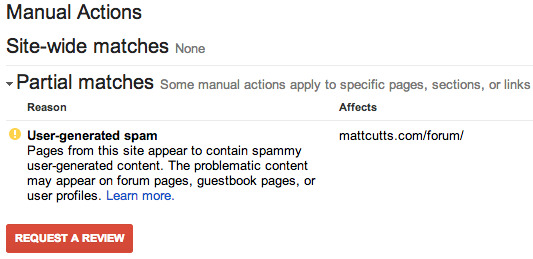Google Webmaster Tools launched its new manual spam actions feature yesterday, enabling verified site owners to check whether their site has been manually penalized by Google.
Over the last couple of years, Google has slowly increased its communication to webmasters, with the goal of fighting webspam by educating site owners on how it impacts their performance in search results. Previously, Google would leave notifications about manual actions taken against a site in the owner’s Webmaster Tools account. This feature augments the notifications with a real-time tool that performs a live check against Google’s internal webspam systems.

A hypothetical example of a site with manual spam actions. Source: Google Webmaster Central Blog
To test the manual actions viewer, log in to your verified Google Webmaster Tools account. Click to the “Manual Actions” report under the “Search Traffic” section. If you haven’t already verified your site in Google Webmaster Tools, this is the perfect excuse to do so.
What Is a Manual Spam Action?
Google combats spammy search results in two ways: manually applied penalties and algorithmic updates designed to remove sites that provide a poor user experience from search results.
Manual actions refer to penalties levied against sites that have been reviewed by real humans on Google’s webspam team and found to violate Google’s quality guidelines. Sites can be penalized in part if the webspam affects only a portion of the site, or the entire site can be penalized. The end result of a manual spam action is decreased organic search traffic. How drastically search performance is reduced depends on the severity of the manual action.
Manual actions are applied across a dozen or so categories of webspam, including thin or low-value content, keyword stuffing and unnatural links.
In the past, site owners were left to wonder if they were suffering from a manual penalty every time their search performance fluctuated more than the typical amount. Speculation on whether the site had been penalized often derailed marketing and systems teams from identifying and resolving the real issues affecting their search performance.
How to Resolve Manual Spam Actions
Perhaps the best aspect of the manual actions tool is the measure of transparency it provides into the reinclusion process.
Historically the process has been very secretive and one-sided. Owners of sites that they felt may have been penalized manually would make their best guess at why they had been penalized, work to fix the issue they thought they might have, and then try to find a contact at Google to hear their plea for forgiveness. Oftentimes there was no reply, either positive or negative, leaving site owners feeling frustrated and wondering what, if anything, would be resolved.
The manual actions tool not only answers the question of whether a site has been manually penalized conclusively, it also provides some information on why it was penalized and which pages were affected.
Most site owners – 98 percent — will see a soothing message reading “No manual webspam actions found” when they use the manual action viewer. The other two percent will be informed of full and partial site actions, and if the action was applied to part of the site, the tool will also list the first 1,000 pages affected by the action to assist site owners in understanding the issue.
Each action listed is accompanied by a link to learn more about those actions from Google’s webmaster help section. Google has also created a series of YouTube videos discussing the various spam categories and what you can do to resolve the issues.
The bottom line to resolving manual actions boils down to fixing the issue and submitting for reinclusion. Large red “Request a Review” buttons also accompany each action listed. Clicking the button will initiate the reinclusion process, wherein real humans on the webspam team will review the site to determine if it merits reversing the manual actions.
Be warned, however, that you should submit a request for reinclusion only after seriously analyzing your site and taking concrete steps to resolve the issues that prompted the manual action. Google’s Webmaster Central Blog recently answered some of the top questions about reinclusion after incurring a link spam penalty, and the advice is relevant across all categories of manual spam actions.
What about Algorithmic Actions?
Far more sites are impacted by Google’s algorithmic actions than by manual penalties. Google now says that only two percent of the domains in its index are affected by manual spam actions, but Google representatives have said recently that a single major algorithm update can affect three or four percent of Google’s rankings.
So where’s the tool to check whether your site has been algorithmically penalized? There isn’t one; at least not a conclusive, Google-sanctioned tool. The best option so far is the Panguin Tool, which visually correlates Google’s major algorithm updates with a site’s Google Analytics data.
With so many sites relying on organic search as a major source of traffic and revenue, the pressure is strong to provide additional tools to help sites perform better today in organic search while following the quality guidelines that ensure long-term success.
While algorithmic actions would be an extremely valuable tool for site owners, Google is concerned that the information provided would give spammers an even greater edge. That was Google’s argument against providing more information on manual spam actions as well, though, so perhaps we’ll see steps toward greater algorithmic transparency as well.



